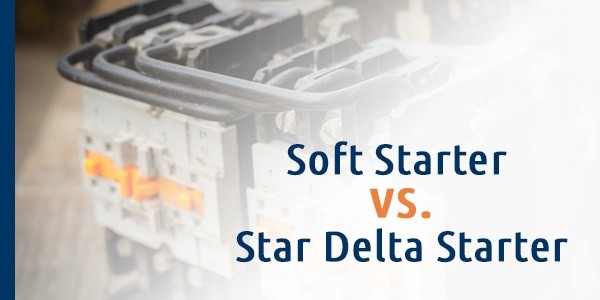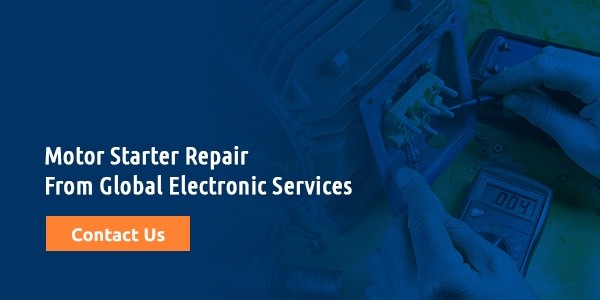Soft Starter vs. Star Delta Starter

Whenever an electric motor starts up, it draws a significant amount of power. This sudden influx of power can damage the motor, lead to voltage dips and cause other issues. To protect against these unwanted effects, you need to select a starting method that enables your motor to start up safely.
Two of these starting methods involve using soft starters and star delta starters. While these two devices have a similar purpose, they differ in many ways. In this article, we’ll define and compare these two technologies to help you choose the right one for your company’s applications.
What Is a Soft Starter?
Soft starters, also call reduced voltage soft starters (RVSS), are solid-state devices that protect AC electric motors from damage due to sudden increases in power during startup. They do so by enabling the power to slowly increase by gradually ramping up the voltage supplied to the motor. They are usually used only at startup, but some can also be used when stopping the motor.
Soft starters may consist of electrical or mechanical components or a combination of both. Mechanical soft starters may use clutches and various kinds of couplings that employ a fluid, steel shot or magnetic forces to transmit torque. Electrical soft starters reduce torque by temporarily changing how the motor connects within the electric current or otherwise reducing current input or voltage through electrical means. Electrical soft starters can control one to three phases. Three-phase control typically produces better results.
Typically, soft starters use silicon controlled rectifiers and thyristors to reduce voltage. In their off state, SCRs restrict current, and in their on state, they allow it. As the motor is ramping up, the SCRs are engaged. Once the maximum speed is achieved, bypass contactors become engaged, which helps to decrease motor heating.
What Is a Star Delta Starter?
Star delta starters are another device that may be used to reduce current demand during motor startup. It is often used for starting three-phase induction motors, but can only be used when starting the motor without load and when the required starting current is relatively low.
With this method, the motor is initially started with a star-connected stator winding. Once the motor reaches a certain speed or a certain amount of time has passed, the motor will run in the normal delta-connected stator winding. Starting with a star connection reduces the voltage across each winding and also decreases torque.
In a star connection, there are four wires. Three of them are phase wires, and the fourth is neutral. The neutral wire is connected at the start point, where the three-phase wires come together. In a delta connection, three are three wires. There is no neutral terminal, although the ground can be employed as a neutral path if needed.
Star delta starters contain a triple pole double throw switch, which is what changes the stator windings from star to delta. They also have three contactors, the main, star and delta contactors, which control the winding currents. They also contain a time relay, a three-pole thermal overcurrent release, and either fuse elements or automatic cut-outs for the circuits.
Soft Starters vs. Star Delta Starters
So, how are soft starters and star-delta starters similar, and how are they different? And which should you use for starting your motor?
Both types of starters serve the same general purpose. They decrease the voltage supplied to a motor during startup to prevent a sudden jump in power that can damage the motor and cause various other issues. However, the main differences are:
- A number of states: Star delta starters only have two states, low voltage, and full voltage, that the starter jumps between. Soft starters, on the other hand, start-up gradually. They can have infinite states within the limits of the controlling electronics and your startup requirements.
- Ability to handle varying load conditions: Soft starters can handle varying load conditions, such as loaded and unloaded starts, while star-delta staters can not.
- Starting time: Soft starters allow you to control the starting time, while star-delta starters do not. The starting time for star-delta starters is about three to seven seconds, while soft starters have an adjustable starting time of between one and around 60 seconds.
- Torque control: Soft starters also offer dynamic torque control, which allows you to adjust the torque to accommodate different motor and load characteristics. With star-delta starters, you can’t adjust the starting torque.
- Soft stop: Some soft starters also offer soft stop functionality, while star-delta starters do not.
- Current reduction with extremely light loads: With extremely light loads, star-delta starters may be able to reduce the starting current to a lower level than a soft starter could.
- Simplicity: Star delta starters are more complicated than soft starters. It is also easier to install soft starters.
- Open transition and power loss: With star-delta starters, between the star and delta connection, there is an open transition that can result in current transients and high torque. The power supply is also lost during this transition. With soft starters, there is no such open transition and no power loss.
- Costs: Soft starters cost more than star-delta starters, although soft starters are more efficient. Today, however, the cost difference between the two types of starters is less than what it once was.
- Applications: Star delta starters can be used for low-power machines starting with load, medium-power machines starting without load, low-power fans and low-power centrifugal pumps. Soft starters can be used with large motors with or without load, including motors used for compressors, fans, pumps, conveyors, agitators, mixers, mills and more.
Should You Use a Soft Starter or a Star Delta Starter?

Which kind of starter should you use with your motor? Soft starters offer more features and easier installation, but star-delta starters offer the advantage of lower cost. Here are some additional reasons to use each type of starter:
Reasons to Use Soft Starters
Soft starters are used more often than star-delta starters today because of their enhanced capabilities and additional features. If you have a larger motor that you start and stop often, a soft starter is the better choice because it’s more efficient than a star-delta starter.
Soft starters are also more flexible than star-delta starters and easier to install. You might also choose a soft starter for the additional capabilities it offers, such as the ability to accommodate varying load conditions, enable soft stops, and adjust the starting time and torque. Soft starters also offer advantages through improved functionality, such as a smooth progressive start, no power loss, built-in protection and long life due to a lack of moving parts
Reasons to Use Star Delta Starters
The main advantage of star-delta starters is their lower cost, although the cost difference is less than it once was. Because of the lower cost, a star-delta starter may be the right choice for a motor that you rarely start or an especially small motor. A star-delta starter may be the best choice for extremely light loads, as it may be able to lower the voltage more than a soft starter could.
Motor Starter Repair From Global Electronic Services
At Global Electronic Services, our experienced team can provide the expert repair and maintenance services your company needs for your motor starters, as well as a wide range of other industrial equipment types. If you have questions about your starters or would like to know more about our repair services, contact us today, and we’ll be happy to assist you.
